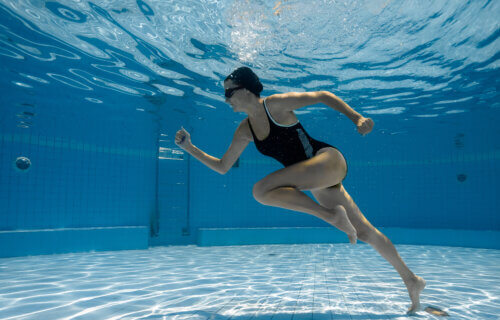OSLO, Norway — High-intensity interval training (HIIT) involves short bursts of intense activity followed by even shorter periods of rest repeatedly. So, for example, 45 seconds of burpees followed by 15 seconds of rest, repeated five times. HIIT has emerged as a top exercise choice in recent years. Now, new findings suggest that taking this activity underwater can help even more.
Aquatic HIIT (AHIIT) can help improve exercise capacity among adults living with chronic conditions and researchers find it’s generally just as beneficial as land-based training (LBHIIT). The research team, made up of scientists from Oslo Metropolitan University and the University of Melbourne, believe AHIIT may represent a safe and valuable alternative for people with chronic conditions unable to perform HIIT on the ground.
Nowadays, many believe HIIT provides more health benefits than moderate-intensity exercise for people — both with and without chronic conditions. HIIT is such an attractive exercise option because it increases aerobic capacity and endurance, and doesn’t take that long either. Working out in water, meanwhile, has been shown to relieve pressure on joints, allowing people to complete movements they wouldn’t be able to perform on land. However, there is conflicting evidence regarding aquatic exercise’s physiological benefits.
So, to analyze the effect of AHIIT, study authors assessed a total of 18 trials that compared how AHIIT improved participants’ exercise capacity (measured via oxygen consumption, walking tests, and physical fitness tests) against LBHIIT, moderate-intensity exercise in water (AMICT), or a non-exercising control cohort.

While the trials were of varying quality, the research team was able to analyze the certainty of evidence using the recognized GRADE system. The results included a total of 868 participants (74% women) who had a range of conditions including back pain, arthritis, chronic lung disease (COPD), Type 2 diabetes, and multiple sclerosis. Some participants were diagnosed with more than one chronic condition.
Differences among the groups were expressed in terms of standardized mean differences (SMD). Typically, an SMD of 0.2-0.5 indicates a small effect, 0.5-0.8 a moderate effect, and 0.8 or more points to a large effect.
Ultimately, the results showed that AHIIT moderately improved participants’ exercise capacity in comparison to no exercise (SMD 0.78) and had a small beneficial effect compared with AMICT (SMD 0.45). No exercise capacity difference was seen when AHIIT was compared with LBHIIT. Fewer adverse events were reported in AHIIT than with LBHIIT, while adherence rates for AHIIT ranged from 84 to 100 percent.
This research was observational in nature, and study authors acknowledge that some of the trials did not include a blind assessor. This may have influenced the findings, not to mention none of the included studies focused on long-term improvements in exercise capacity or quality of life.
Still, the study’s detailed search strategy, as well as its inclusion of several chronic conditions, adverse events, and adherence, enabled a much greater depth of understanding of AHIIT across a variety of populations.
“A key finding of this meta-analysis indicates that AHIIT may be as beneficial as LBHIIT, which gives people with chronic conditions another choice for effective HIIT or potentially a more successful environment to start and continue with high-intensity training,” the researchers write in the media release, noting that the natural support and buoyancy of water “may facilitate this effectiveness.”
Moving forward, study authors suggest future research should focus on the link between exercise capacity and key patient-related outcomes, barriers to HIIT, and the ongoing independent commitment to fitness.
The study is published in the BMJ Open Sport & Exercise Medicine.
You might also be interested in:
- Get fit with HIIT: Just 15 minutes of high-intensity exercise improves heart function
- Best Core Exercises: Top 5 Moves To Build Your Abs, According To Experts
- Run for your life! Cardio exercise could significantly slash flu, pneumonia death risk

